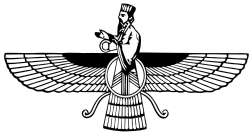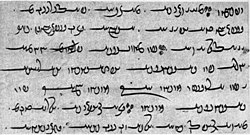Gatha (Zoroaster)
| Gatha | |
|---|---|
| Information | |
| Religion | Zoroastrianism |
| Author | Zarathustra |
| Language | Avestan |
| Part of a series on |
| Zoroastrianism |
|---|
 |
|
|
The Gathas (/ˈɡɑːtəz, -tɑːz/)[1] are 17 hymns in the Avestan language from the Zoroastrian oral tradition of the Avesta. The oldest surviving text fragment dates from 1323 CE,[2] but they are believed by scholars to have been composed before 1000 BCE and passed down orally for centuries.[3][4] They are traditionally believed to have been composed by the prophet Zarathushtra (Zoroaster) himself. They form the core of the Zoroastrian liturgy (the Yasna). They are arranged in five different modes or metres.
The Avestan term gāθā (𐬔𐬁𐬚𐬁 "hymn", but also "mode, metre") is cognate with Sanskrit gāthā (गाथा), both from the Proto-Indo-Iranian word *gaHtʰáH, from the root *gaH- "to sing".
Structure and organization
[edit]
The Gathas are in verse, metrical in the nature of ancient Iranian religious poetry, that is extremely terse.
The 17 hymns of the Gathas consist of 238 stanzas, of about 1300 lines or 6000 words in total. They were later incorporated into the 72-chapter Yasna (chapter: ha or had, from the Avestan ha'iti, 'cut'), that in turn is the primary liturgical collection of texts within the greater compendium of the Avesta. The 17 hymns are identified by their chapter numbers in the Yasna, and are divided into five major sections:
| 28–34 | Ahunavaiti Gatha | (cf. Ahuna Vairya), 100 stanzas, (3 verses, 7+9 syllable meter) | ||
| 43–46 | Ushtavaiti Gatha | 'Having Happiness', 66 stanzas (5 verses, 4+7 syllable meter) | ||
| 47–50 | Spenta Mainyu Gatha | 'Bounteous Spirit', 41 stanzas (4 verses, 4+7 syllable meter) | ||
| 51 | Vohu Khshathra Gatha | 'Good Dominion', 22 stanzas (3 verses, 7+7 syllable meter) | ||
| 53 | Vahishto Ishti Gatha | 'Best Beloved', 9 stanzas (4 verses, two of 7+5 and two of 7+7+5 syllables) |
With the exception of Ahunavaiti Gatha, that is named after the Ahuna Vairya prayer (Yasna 27, not in the Gathas), the names of the Gathas reflect the first word(s) of the first hymn within them. The meter of the hymns is historically related to the Vedic tristubh-jagati family of meters.[5] Hymns of these meters are recited, not sung.
The sequential order of the Gathas is structurally interrupted by the Yasna Haptanghaiti ("seven-chapter Yasna", chapters 35–41, linguistically as old as the Gathas but in prose) and by two other minor hymns at Yasna 42 and 52.
Language
[edit]The language of the Gathas, Gathic or Old Avestan, belongs to the old Iranian language group that is a sub-group of Eastern families of the Indo-European languages. Although arising from the same family, it is still not possible to translate them using Proto Sanskrit or Pali. Sassanid era translations and commentaries (the Zend) have been used to interpret the Gathas, but by the 3rd century the Avestan language was virtually extinct, and a dependency on the medieval texts is often discouraged as the commentaries are frequently conjectural. While some scholars argue that an interpretation using younger texts is inadvisable (Geldner, Humbach), others argue that such a view is excessively skeptical (Spiegel, Darmesteter). The risks of misinterpretation are real, but lacking alternates, such dependencies are perhaps necessary.
"The Middle Persian translation seldom offers an appropriate point of departure for a detailed scholarly approach to the Gathas, but an intensive comparison of its single lines and their respective glosses with their Gathic originals usually reveals the train of thought of the translator. This obviously reflects the Gatha interpretation by the priests of the Sasanian period, the general view of which is closer to the original than what is sometimes taught about the Gathas in our time."[6]
The problems that face a translator of the Avestan Gathas are significant: "No one who has ever read a stanza of [the Gathas] in the original will be under any illusions as to the labour that underlies the effort [of translating the hymns]. The most abstract and perplexing thought, veiled further by archaic language, only half understood by later students of the seer's own race and tongue, tends to make the Gathas the hardest problem to be attempted by those who would investigate the literary monuments."[7]
Content
[edit]Some of the verses of the Gathas are directly addressed to the Omniscient Creator Ahura Mazda. These verses, devotional in character, expound on the divine essences of truth (Asha), the good-mind (Vohu Manah), and the spirit of righteousness. Some other verses are addressed to the public that may have come to hear the prophet, and in these verses, he exhorts his audience to live a life as Ahura Mazda has directed, and pleads to Ahura Mazda to intervene on their behalf.
Other verses, from which some aspects of Zoroaster's life have been inferred, are semi-(auto)biographical, but all revolve around Zarathustra's mission to promote his view of the Truth (again Asha). For instance, some of the passages describe Zarathustra's first attempts to promote the teachings of Ahura Mazda, and the subsequent rejection by his kinsmen. This and other rejection led him to have doubts about his message, and in the Gathas he asked for assurance from Ahura Mazda, and requests repudiation of his opponents.
References
[edit]Notes
[edit]- ^ "Gatha". Random House Webster's Unabridged Dictionary.
- ^ Boyce 1984, p. 1.
- ^ Hale, Mark (2008). "Avestan". In Woodward, Roger D. (ed.). The Ancient Languages of Asia and the Americas. Cambridge University Press. pp. 101–122. ISBN 978-0-521-68494-1.
- ^ Skjaervo, P. Oktor (2012). "The Zoroastrian Oral Tradition as Reflected in the Texts". In Cantera, Alberto (ed.). The Transmission of the Avesta. Iranica. Vol. 20. Wiesbaden: Harrassowitz. pp. 3–48. ISBN 978-3-447-06554-2.
- ^ Schlerath, Bernfried (1969), "Der Terminus aw. Gāθā", Münchener Studien zur Sprachwissenschaft, 25: 99–103
- ^ Humbach, Helmut (2001), "Gathas: The texts", Encyclopedia Iranica, vol. 10, Costa Mesa: Mazda.
- ^ Moulton, James Hope (1906), "Bartholomae's Lexicon and Translation of the Gathas (Review)", The Classical Review, 20 (9): 471–472, doi:10.1017/s0009840x00995398
Works cited
[edit]- Boyce, Mary (1984), Textual Sources for the Study of Zoroastrianism, Manchester UP.
Further reading
[edit]- Malandra, William (2001), "Gathas: Translations", Encyclopedia Iranica, vol. 10, Costa Mesa: Mazda.
Selected translations available online:
- Bartholomae, Christian (1951), Taraporewala, Irach Jehangir Sorabji (trans.) (ed.), Divine Songs of Zarathushtra: A Philological Study of the Gathas of Zarathushtra, Containing the Text With Literal Translation into English, Bombay: K. R. Cama Oriental Institute
Bartholomae's translations ("Die Gatha's des Awesta", 1905) were re-translated into English by Taraporewala. The raw texts, sans commentary or introduction, are available online - The PDF version of The Divine Songs of Zarathushtra by Irach J. S. Taraporewala is published by FEZANA online
- Irani, Dinshaw Jamshedji; Tagore, Rabindranath (1924), The Divine Songs Of Zarathushtra, London: Macmillan
Complete text of the book including introduction and a plain English synopsis of each verse is available online - Skjærvø, Prods Oktor (1999), "Avestan Quotations in Old Persian? Literary sources of the Old Persian Inscriptions", in Shaked, Saul; Netzer, Amnon (eds.), Irano-Judaica IV, Jerusalem: Makhon Ben-Zvi (Ben-Zvi Institute), pp. 1–64
